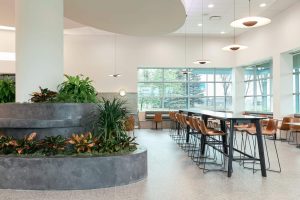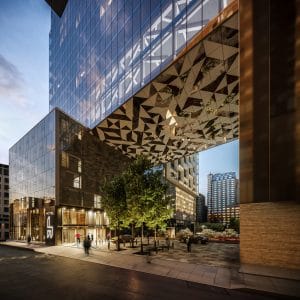- June 30, 2021
After a year of staying close to home, we recognized that our design process should prioritize the well-being of those who use our spaces. The concept of biophilia, when applied to design, means reconnecting humans with nature in order to improve their overall well-being. At a time when we’ve been asked to evolve from our previous way of life, creating this connection becomes an opportunity to innovate for all members of our extensive team.
According to numerous studies in urban areas, when natural elements are integrated into a person’s living or office space, it can have a positive influence on that person’s emotions and perceptions. Although the integration of plants is the most obvious strategy in terms of improving comfort and helping productivity and performance, biophilia design is not just about plants. The concept is centred upon the well-balanced and thoughtful integration of elements like stone, wood, water or natural light. Whether it is integrated visually or not, the connection of humans with nature allows for better productivity, a sense of calm, but also of evolution. By adding elements to the environment that evoke nature through touch, smell, sight or sound, it is possible to influence emotion in the short and long term. Examples of biophilic integrations in our environments are more present than we think. Whether it is a fountain at the heart of a building complex, which allows reconnection with water and contributes a soothing soundtrack to the space, or the integration of wood in railings and walls to give a sense of freshness and balance. We are much more influenced by our environment than we think.
Connect First offices: A haven in the middle of a skyscraper
An example of how design can emphasize the benefits of nature, the Connect First space features natural wood accents as a primary material. This choice is no accident, as the light-coloured wood with its exposed grain evokes the calm aspect of nature. This is an ideal feeling for any office space. The open space, which combines common islands and individual workspaces, is bathed in mostly natural light. An ecological choice, but also a strategic one. As the hours pass, the tone of the office space varies in its colours.
 It is difficult to be indifferent these changes in light and the luminosity subconsciously influences mental and physical productivity. This same light that ensures a better quality of life for employees also helps the many plants that act as natural filters for the ambient air. This creates the effect of a haven in the middle of a skyscraper. As we prepare for our eventual return to the office, we have an opportunity to rethink how we design work spaces. Read about 5 changes that will change the office of tomorrow here.
It is difficult to be indifferent these changes in light and the luminosity subconsciously influences mental and physical productivity. This same light that ensures a better quality of life for employees also helps the many plants that act as natural filters for the ambient air. This creates the effect of a haven in the middle of a skyscraper. As we prepare for our eventual return to the office, we have an opportunity to rethink how we design work spaces. Read about 5 changes that will change the office of tomorrow here.
Humaniti: Creating a sense of calm in the city
Big city living can be designed to not only co-exist alongside nature, but also connect and flourish with it. Located in the heart of Montreal, the Humaniti vertical village was designed to embrace the green spaces that surround it. The project reconnects the urban dweller with a natural environment. By designing apartments that have access to daylight and views, our team proposes a lifestyle where the need for artificial lighting is reduced, and where natural light is diffused to ensure a sense of change and movement. The physical effects are also evident, as we witness how a design strategy can synchronize the circadian rhythm of the inhabitants, reduce stress, and positively impact the regulation of vitamin D, serotonin and melatonin needed for restful sleep and a clear mind.

In an effort to create a sense of calm in an otherwise dynamic and connected context, a fountain can be found in the center of the public square.
This fountain allows residents and visitors to connect with the water and benefit from its soothing aspect generated by the fluidity of its sound and the theatrical aspect of its light. The project also features the famous “La Joute” sculpture by Canadian sculptor Jean-Paul-Riopelle, and is yet another element that playfully speaks to the inhabitants of its majestic neighbour. Interior design can also invite the natural world inside. The colour scheme chosen for Humaniti is based on those we find in natural spaces, providing a continuous connection with nature.
At a time when our society is reemphasizing the importance of the way we live and move, placing well-being at heart of our design is of utmost importance. This allows architects, designers, and landscape architects to ensure that the people that use the spaces are happy and safe, but also that they will want to return to shared spaces. Since design is above all a collective endeavor, human well-being is at the heart of our work.